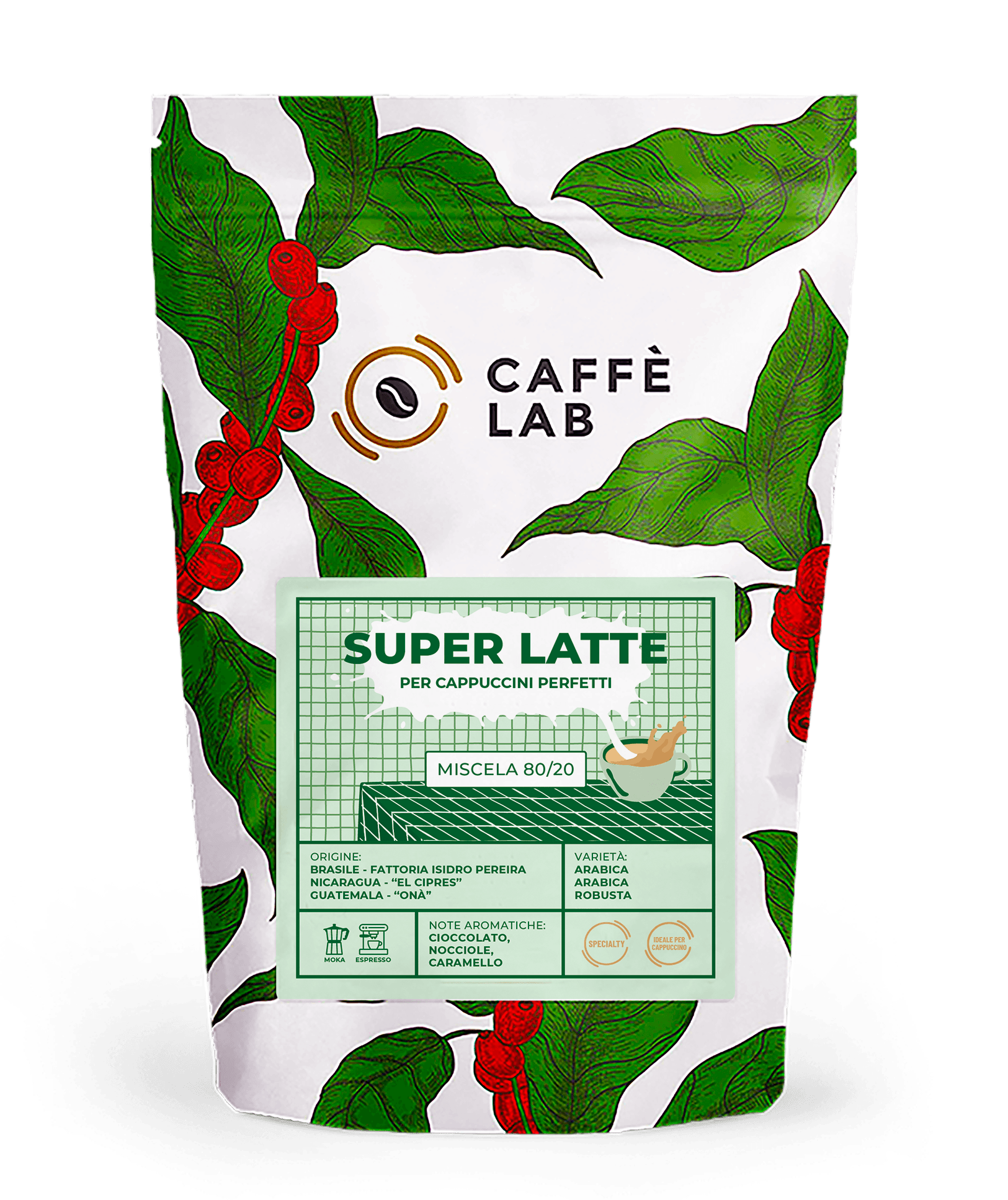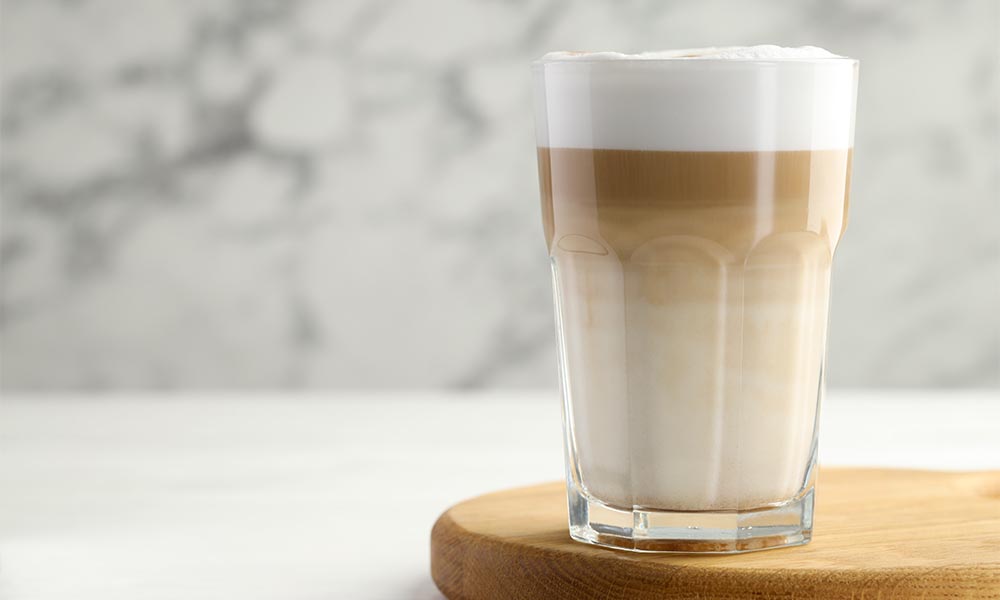
Super Latte
Cappuccino Blend


What is the difference between cappuccino and latte macchiato? It’s a question every coffee lover has asked at least once, perhaps while standing at the bar counter, torn between two drinks that, while similar in appearance, conceal substantial differences. The distinction doesn’t only concern the proportions between milk and coffee, but also involves the preparation, foam structure, temperature, and final effect on the palate.
Discover together with CaffeLab the characteristics of each beverage: we’ll explain how they’re made, what the technical and sensory differences are, and especially when it’s better to choose one over the other, depending on personal taste and time of day.
Cappuccino is deeply rooted in Italian tradition. The name refers to the color of the Capuchin monks’ robe, a light brown shade obtained from the homogeneous mix of espresso coffee and steamed milk in the milk jug. It’s a symbolic drink of the Italian breakfast, often paired with a croissant and mainly consumed in the morning. Its origins date back to the spread of coffee in Europe, within the Austrian Empire of the 17th–18th century.
To create a delicious and original beverage, getting a cappuccino machine is the winning choice. With the CaffeLAB Super Latte, you can prepare a perfect cappuccino at home, as good as at the bar!
Latte macchiato, on the other hand, is a more recent and versatile creation, born to meet the desire for a beverage less intense than a cappuccino yet still aromatic, suitable even for those who prefer a softer flavor profile. It has gained great popularity not only in Italy but also abroad, where it is often ordered as “milk with a dash of espresso” or simply “Macchiato.”

Preparing a cappuccino requires precision, technique, and attention to foam texture. You start with a single espresso (about 25 ml), to which you add whole milk or a plant-based beverage, previously frothed using the steam wand or our Nanofoamer, until you obtain a creamy, compact, and velvety microfoam. The total volume of a standard cappuccino is at least 150 ml. The distinctive feature is the balance between the three components: espresso, hot milk, and milk foam. When properly made, cappuccino has a glossy, even surface with dense and persistent foam. It’s also the perfect base for those practicing latte art, as the microfoam allows for decorative designs. Thanks to our Specialty blend specially designed for home cappuccino lovers, you can enjoy it whenever you like!
In latte macchiato, the order of the ingredients is reversed: first, the hot, frothed milk is poured into the cup or tall glass, then a small amount of espresso is added, which “stains” the milk — hence the name of the drink.
Visually, latte macchiato often shows clear layers: hot milk at the bottom, coffee in the center, and foam on top. Compared to cappuccino, the proportion is clearly shifted in favor of milk, and the coffee’s intensity is more muted. The taste is softer and less persistent, perfect for those who want a hot and aromatic beverage that isn’t too strong.
The difference isn’t just in the name or presentation. It’s a structural and taste-based distinction that is immediately noticeable from the first sip.
In cappuccino, Italian espresso is the star: the espresso crema blends with the milk creating a full and balanced flavor, with a body that remains present in the mouth. The foam is compact, silky, and perfectly integrated with the liquid part.
In latte macchiato, on the other hand, coffee plays a secondary role. It is poured over already frothed milk, remaining partly on the surface and partly suspended. The result is a beverage in which the milky component prevails, and the coffee note is perceived as an aromatic hint, not as a structural base. If in a 160/180ml cappuccino, coffee makes up about 1/5 of the drink, in a latte macchiato served in a larger glass (250/300ml), coffee represents about 1/8 to 1/10.
Even the consistency of the foam changes. Cappuccino foam is microtextured, fine and shiny. In latte macchiato, the foam can be more voluminous but also less compact, creating a stronger contrast with the liquid below.

The choice between cappuccino and latte macchiato doesn’t depend only on personal taste, but also on context and time of day. Cappuccino, due to its intensity and marked coffee presence, is perfect in the morning, when you need an extra boost without giving up the comfort of warm milk.
Latte macchiato, instead, is ideal as a break drink, to be enjoyed in the afternoon or even after dinner for those who want something light, warm, and aromatic, without a strong caffeine impact.
For those mindful of nutritional composition, it’s useful to know that latte macchiato contains more milk and less coffee, thus slightly more caloric but less stimulating. Cappuccino, in proportion, has a higher caffeine component but a lower calorie intake, especially if skimmed milk is used.
Whether you choose cappuccino or latte macchiato, what truly makes the difference is the quality of the ingredients and the care in preparation. Using a good espresso as a base is essential: fresh coffee, well-roasted and freshly ground, is the foundation for both drinks.
But it’s the milk that plays the key role in the difference between the two. For a perfect cappuccino, the ideal milk temperature is around 65°C, not to be exceeded to avoid losing natural sweetness and developing burnt notes. For latte macchiato, it’s better to stay slightly below, to maintain layer separation and facilitate stratification.
Milk frothing must be done carefully: a clean steam wand, a cold steel pitcher, and the right steam angle are essential steps. On CaffeLab, you’ll find professional milk-frothing accessories, barista thermometers, pitchers, and machines suitable for achieving true coffeehouse results at home.
Choosing between cappuccino and latte macchiato is a matter of taste, of course, but also of knowledge. Knowing how to distinguish them is not just a curiosity for baristas: it’s a way to better appreciate the variety of the coffee world and to prepare at home tailor-made drinks for every need. Keep exploring CaffeLab’s guides to discover all the secrets of quality coffee.